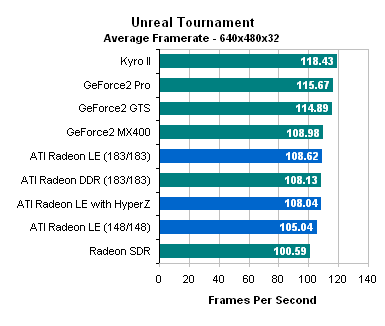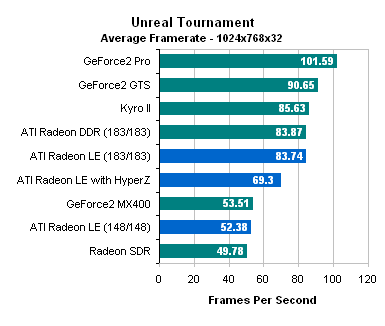DX7 Performance - Unreal Tournament
Unreal Tournament provided us with a Direct3D game with which to test the effectiveness of the Radeon LE's HyperZ capabilities once the appropriate registry keys had been added. In the following graphs, the bar labeled "ATI Radeon LE with HyperZ" refer to the standard Radeon LE card with HyperZ enabled. The "ATI Radeon LE (183/183)" bar represents the Radeon LE running at 183MHz with HyperZ enabled as well.

In Unreal Tournament at 640x480x32, essentially all the cards perform the same. It is interesting that the Radeon LE is actually able to gain more performance at this resolution by enabling HyperZ than by overclocking the card to 183MHz. This seems to accurately reflect the memory intensive nature of the Unreal engine, as HyperZ can provide significant improvement as we have already seen.

The Radeon LE performs nearly the same as both the Radeon SDR and the GeForce2 MX in Unreal Tournament at 1024x768x32. A bit of tweaking separates the card from the pack.
Enabling HyperZ provided a big boost for the Radeon LE at 1024x768x32. Simply adding the 3 registry keys described above allowed for a 32% performance increase. Add to this the 35MHz we overclocked the card and the Radeon LE gets new life, performing a full 60% faster than the standard Radeon LE. This brings the card's performance to Radeon DDR levels, as we have seen before.

With HyperZ disabled and a massive amount of data traveling over the memory bus at 1600x1200x32, the Radeon LE gets trumped by every other card tested. This is first alleviated by enabling HyperZ, allowing the Radeon LE to realize a 43% performance increase. When overclocked to Radeon DDR speeds, the card performs within 4% of the Radeon DDR and 75% faster than how it comes out of the brown box.










0 Comments
View All Comments